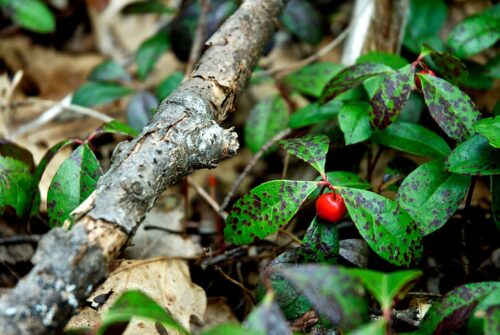Beyond functioning as culinary herbs, many aromatic plants are excellent sources of essential oils due to their fragrances that help soothe the senses. A previous post entitled ‘Rosemary Varieties: Discover the Ultimate Collection of Aromatic Choices’ perfectly illustrates this by discussing the medicinal properties and health benefits of rosemary cultivars. As such, rosemary essential oil can be used for pain relief, relaxation, and stress reduction.
In the same vein, wintergreen is a group of aromatic, evergreen shrubs native to the United States and Canada. Coming from the heath family Ericaceae, the perennial wintergreen plant has bright red berries and glossy leaves even in winter. Several cultivars of wintergreen vary by berry size, fall foliage color, and plant height and spread. For example:
- ‘Cherry Berries’ is characterized by white flowers, red ornamental berries, and glossy green foliage that turns deep red in the winter.
- ‘Winter Flash’ has white-and-green variegated leaves, which glow pink in the winter, while also producing bright red berries in the fall.
- ‘Berry Cascade’ is a creeping native that has small white flowers, which grow into berries along the stem from late summer through late winter.
Ultimately, this native plant has various therapeutic and industrial applications — entailing a closer look at how it is typically cultivated and processed.
How to grow wintergreen

The specific growing conditions for wintergreen can vary according to type. However, an article in The Spruce explains that it is usually planted in early spring with partial shade and filtered sunlight so it can produce blossoms and fruit. In terms of soil quality, wintergreen plants require well-drained, acidic soil with a pH between 4.5 and 6.0. Consistent moisture and mild to average high humidity are also essential to optimal plant health. Since wintergreen can adapt to and grow even in nutrient-poor soil, plants only need leaf mold in place of fertilizer.
How wintergreen is processed into oil
The production of wintergreen essentials oil typically uses two species, namely Gaultheria procumbens and Gaultheria fragrantissima. The wintergreen leaf itself is odorless, but oil can be extracted from the plant material, before being fermented and distilled to obtain a pure product. During the distillation process, the glycoside gaultherin of the wintergreen plant is converted to methyl salicylate.
While this active ingredient has analgesic and anti-inflammatory properties useful for pain relief, consumers must be aware of products like the Best Naturals organic wintergreen essential oil, which has been recalled due to the lack of child-resistant packaging for its methyl salicylate content. Methyl salicylate can be particularly toxic to children who may ingest wintergreen oil due to its pleasant odor.
Beyond essential oils: industrial applications of wintergreen
Cigarette alternatives
Besides extracting essential oils, manufacturers of cigarette alternatives, such as the increasingly popular pouches that deliver nicotine doses through discreet oral absorption, have also tapped into wintergreen for aroma and flavoring. Best-selling American pouch brand ZYN’s wintergreen nicotine pouches, in particular, provide smokers looking to quit with an invigorating and refreshing nicotine experience due to its icy burst of flavor. The use of wintergreen in these oral, smoke-free pouches further encourages smokers to quit on top of giving them strength options ranging from 3 to 6mg.
Dermatological treatments
Wintergreen also has cosmetic applications, mainly due to its antioxidant and anti-inflammatory properties. A study published in the Journal of Ethnopharmacology found that the American wintergreen’s leaf, stem, and fruit extracts can help protect dermal fibroblast, the main cell type in connective tissue, from ultraviolet-A radiation and damage. The potent antioxidants present in the wintergreen plant can also be used to treat blemishes and inflammatory skin conditions like rashes, which is why brands like Avena have wintergreen ointments and topical creams.
Beekeeping
While the connection between wintergreen and beekeeping might not be obvious, the industry utilizes the plant oil as a natural pesticide. Specifically, wintergreen oil exhibits pesticidal activity against varroa mites and other seasonal insects that infest beehives. Beekeepers also mix wintergreen oil and sugar syrup with a 1:1 ratio to either feed it to bees or spread it over their bodies, thus automatically repelling mites and predators for optimal beehive maintenance.
Clearly, wintergreen is a native plant that has an impressive range of uses across industries. Continue reading Lotus Magus for more resources on plant care and benefits.
